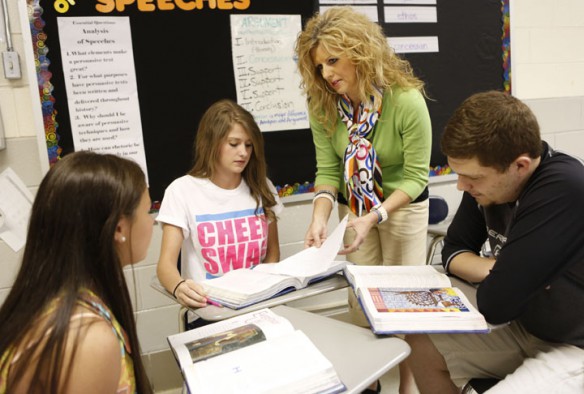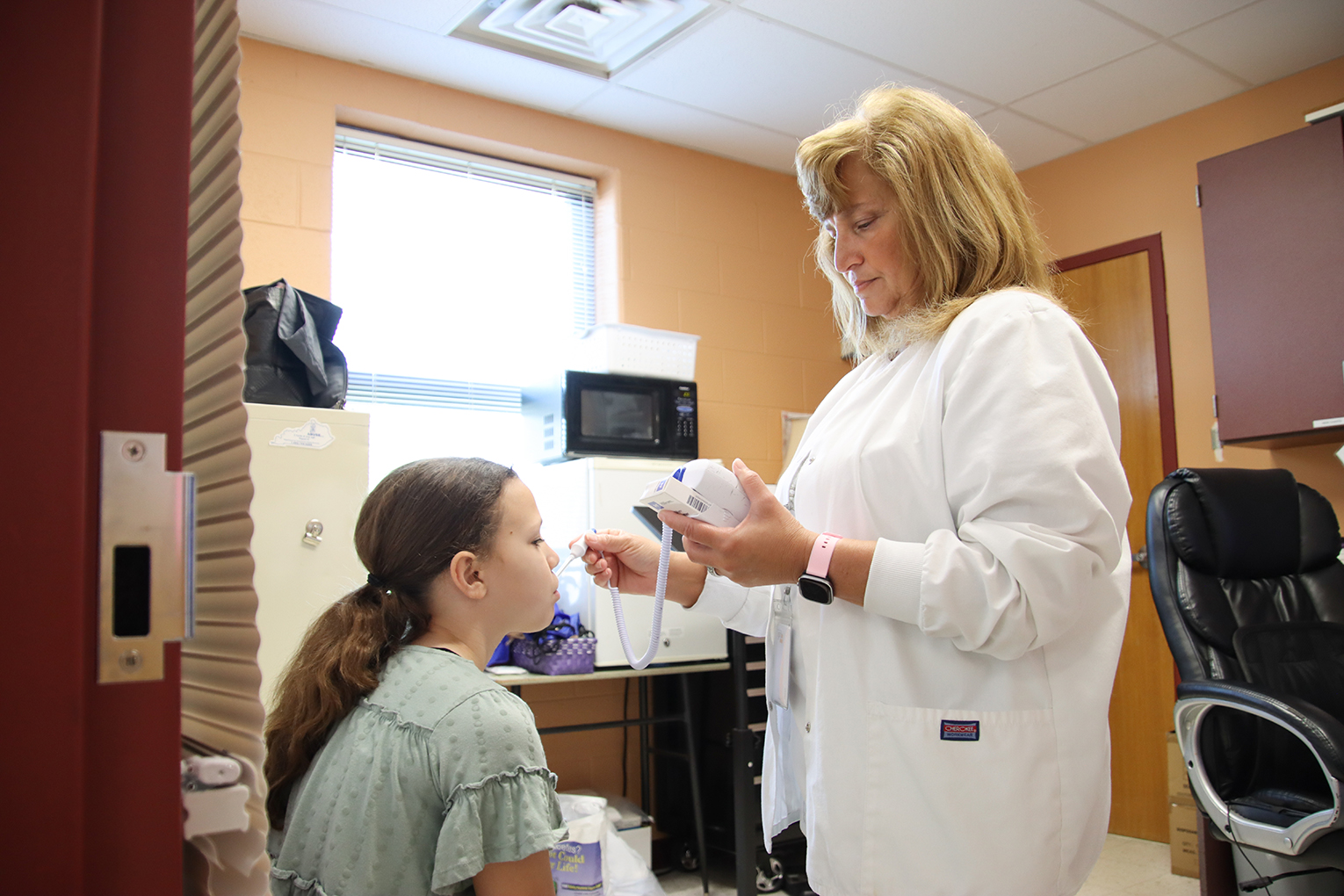
Language arts teacher Christi Lefevers has a literary discussion with sophomores Kaite Mason, Taelor Lawson and Adam Jones at Bell County High School. Photo by Amy Wallot, April 18, 2013
By Susan Riddell
Jennifer Yankey remembers the first vertical meeting of district middle and high school English/language arts (ELA) teachers being very quiet.
“I think we were all trying to figure out our purpose,” Yankey said. “But we’re not quiet anymore.”
Yankey, an English/language arts curriculum specialist for the Bell County school district, said this particular professional learning community (PLC) has helped teachers reinvigorate English/language arts classes within the district.
“Sometimes, we get stuck in our own world, in our own realm of teaching,” Yankey said. “Now, we’re sharing and growing together professionally.”
Maybe just as important, teachers are coming together to better understand the Kentucky Core Academic Standards; improve practices and leadership skills; and create a culture of unity across grade levels.
“This experience has opened a line of communication that did not exist before,” said Bell County High School teacher Christie Willis.
Willis and Yankey spearheaded quarterly ELA meetings following a push to promote advanced placement (AP) classes at the middle school level once Bell County High received an AdvanceKentucky grant.
Yankey said the first vertical meeting was facilitated by high school teachers. To incorporate more participation, different grade levels took turns hosting each meeting. As presentations differed, more conversations started taking place.
The information shared has benefited everyone in one way or another, Yankey said.
Bell County High teacher Christi Lefevers said the vertical team meetings help all teachers because it gets them out of isolation in individual classrooms and helps them concentrate on their part of the Kentucky Core Academic Standards.
“We continually discuss the big picture and what it means to have students graduate from high school being college and career ready,” Lefevers said. “A common question heard during these meetings is, ‘What do you need me to do in order to help you?’ This is applicable to all grades. We begin with the end in mind and work backward trying to align our curriculum vertically.”
That was something Page School Center (P-8) teacher James Blevins was glad to see. Blevins, who teaches 7th and 8th grade, said it bothered him when he realized his students completed a reading assignment better suited for high school grades. He doesn’t worry about that happening again after a March meeting dealt with grade level reading lists. He now knows what high school teachers are having their students read.
“Vertical team meetings help me avoid awkward curriculum mishaps such as these,” Blevins said.
In the fall meeting, Blevins presented using a text annotation lesson from Where the Red Fern Grows by Wilson Rawles. His presentation focused on annotating a text for diction and figurative language.
The vertical meetings also helped changed Blevins’ mind about the use of T-charts as a graphic organizer. The T-chart wasn’t a favorite of his, and he hardly ever used it in his classroom.
“One of my colleagues demonstrated how she used the T-chart with her students to compare texts,” Blevins said. “It was then it clicked for me.”
Blevins now incorporates T-charts into his lessons more frequently.
“One specific unit I found it to be particularly beneficial with was our literacy non-fiction unit,” Blevins said. “The use of this graphic organizer during this unit of study better allowed my students to look for textual evidence that supported common themes in Winston Churchill’s speech “Blood, Toil, Tears and Sweat” and World War II: Life on the British Homefront.”
Willis has made several presentations including a current events activity that she first heard at a summer AP training. She got great responses from the lower grade teachers who adapted the model to fit in their classrooms.
In turn, she has benefitted from the discussion involving argument thesis. “My students were having a hard time seeing the concession,” Willis said. “Once I showed them that their concession was actually in their thesis, it opened the door for understanding.”
Lefevers, who also presented on text annotation and analytical essay writing for End-of-Course exams, said she revisited her Laying the Foundation training that guides teachers in improving student critical thinking skills and added lessons into her classroom from it that meet the Kentucky Core Academic Standards for her grade levels.
“Watching an elementary teacher present his Laying the Foundation lesson over a Shakespearean sonnet and hearing the success rate of students’ analytical paragraphs and depth of critical thinking inspired me,” Lefevers said.
Other presentations have focused on districtwide standard thesis format, argument writing organization and guidelines, novel unit studies, curriculum alignment, test analysis and organizational topics.
Special education teachers and some district grades 4-5 teachers also have attended the meetings.
Yankey said that she has been impressed by the teachers’ commitment to growth that the meetings have fostered.
“At first, it was difficult because none of us knew what to expect,” she said. “But everyone committed to the meetings. At each one, more people were talking and getting more comfortable with sharing both successes and concerns.
“We’re developing a common language and bridging any gaps we come across,” Yankey added. “It’s been exciting to be a part of this.”
MORE INFO …
Jennifer Yankey, jennifer.yankey@bell.kyschools.us, (606) 337-1412







Leave A Comment